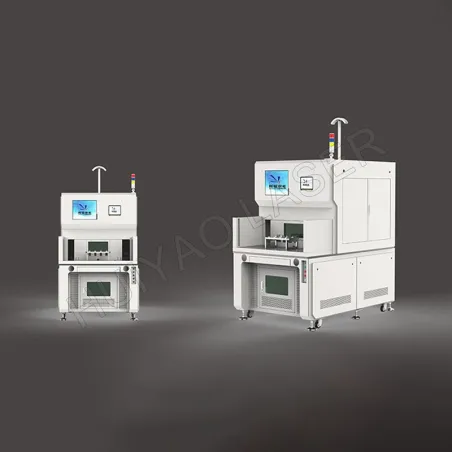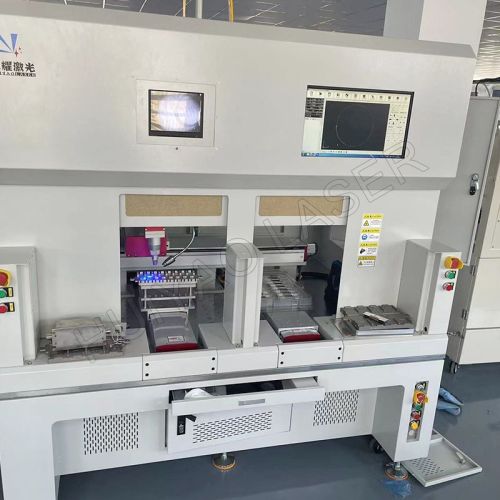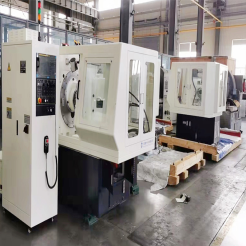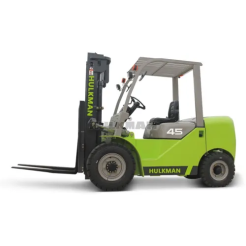Prismatic lithium battery explosion valve laser welding machine
Prismatic lithium battery explosion valve laser welding machine
Product Description
1. Description:
Prismatic lithium battery explosion valve laser welding machine has high equipment utilization rate which can weld a variety of products for blade lithium battery module or packs
High utilization rate of equipment, can weld a variety of products;
Easy to replace, modular design, can quickly replace the fixture;
High positioning accuracy, simple operation, CNC programming or teaching method, easy to understand;

2. Prismatic lithium battery laser welding machine technical parameter
|
Model |
HY-1000w-6000w |
|
Laser source |
1000w-6000w |
|
XYZ Travel |
customized |
|
R Axis |
Optional, 360° rotation |
|
Position Accuracy |
±0.02mm |
|
Repeatability Accuracy |
±0.01mm |
|
Motion Source |
Servo motor |
|
Max Speed |
500mm/s |
|
Cooling Method |
Water cooling |
|
Electricity Demand |
customized |
|
Laser Wavelength |
1080nm |
|
Observation Syatem |
CCD system |
|
Gas Protection |
Optional, Argon, Nitrogen |
|
Environmental Requirements |
No vibration, interference and ventilation |
|
Welding Penetration |
0.1~3.0mm |
|
Fixture |
customized |
|
MOQ |
1 set |
3. Functions:
1. Battery tab welding
The tabs are usually divided into three materials. The positive electrode of the battery is made of aluminum, and the negative electrode is made of nickel or nickel-plated copper. In the manufacturing process of power batteries, one of the links is to weld the battery tabs and poles together. In the production of the secondary battery, it needs to be welded together with another aluminum safety valve. Welding not only needs to ensure a reliable connection between the lug and the pole, but also requires smooth and beautiful weld seams.
2. The power battery shell and the cover plate are sealed and welded
The casing materials of the power battery include aluminum alloy and stainless steel (stainless acid-resistant steel), among which aluminum alloy is used more, generally 3003 aluminum alloy, and a few use pure aluminum. Stainless steel is a laser weldable material, especially 304 stainless steel, whether it is pulsed or continuous laser, it can obtain welds with good appearance and performance.
The laser welding performance of aluminum and aluminum alloys (melting point 660°C) varies slightly depending on the welding method used. Except for pure aluminum and 3-series aluminum alloys, there is no problem with pulse welding and continuous welding, and continuous laser welding is used for other series of aluminum alloys to reduce crack sensitivity. At the same time, according to the thickness of the power battery shell, choose a laser with appropriate power (referring to the amount of work done by the object in unit time). Generally, when the shell thickness is less than 1mm, you can consider using a single-mode laser within 1000W. Use more than 1000W single-mode or multi-mode laser.
Small-capacity lithium batteries often use relatively thin aluminum shells (thickness is about 0.25mm), and there are also steel shells such as 18650. Due to the thickness of the case, the welding of this type of battery generally uses a lower power laser. Using a continuous laser to weld thin-shell lithium batteries can increase the efficiency by 5 to 10 times, and the appearance and sealing are better.
3. Battery explosion-proof valve welding
The explosion-proof valve of the battery is a thin-walled valve body on the battery sealing plate. When the internal pressure of the battery exceeds the specified value, the explosion-proof valve body ruptures to prevent the battery from bursting. The structure of the safety valve is ingenious, and this process has strict requirements on the laser welding process. Continuous laser welding can achieve high-speed and high-quality welding, and welding stability, welding efficiency and yield can be guaranteed.
4. Spot welding of battery poles
The materials used for battery pole strips include pure aluminum strips, nickel strips, aluminum-nickel composite strips, and a small amount of copper strips. Welding of battery pole strips generally uses a pulse welding machine. QCW quasi-continuous laser has good beam quality and small welding spots. Below 1.5mm) welding has unique advantages.
5. Power battery module and pack welding
The series-parallel connection between power batteries is generally completed by welding the connecting piece and the single battery. The positive and negative electrodes are made of different materials, generally copper and aluminum. Ultrasonic welding is usually used. Copper and copper, aluminum and aluminum are generally homogeneous. Laser welding is used. Both copper and aluminum have fast heat transfer, high laser reflectivity, and relatively large thickness of the connecting piece, which requires high-power laser welding.






